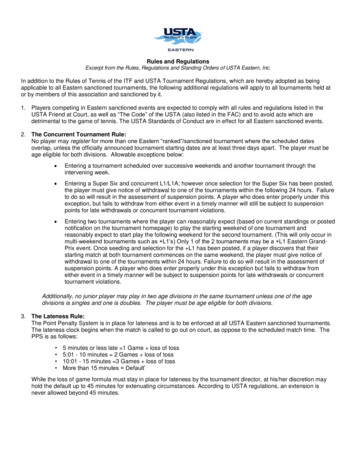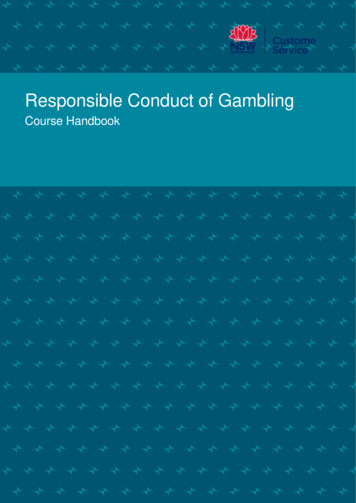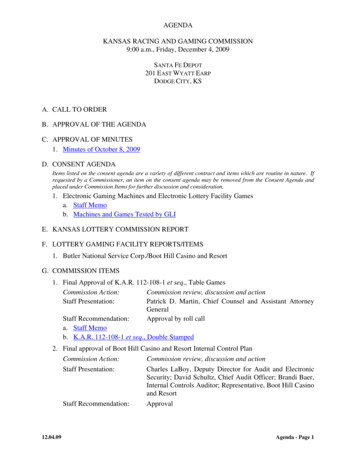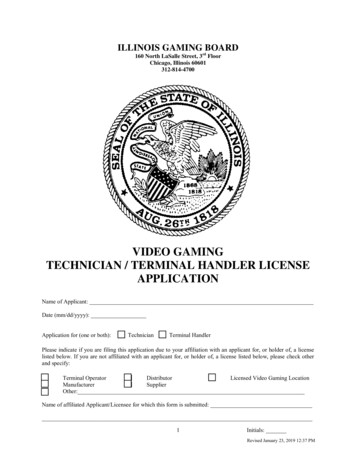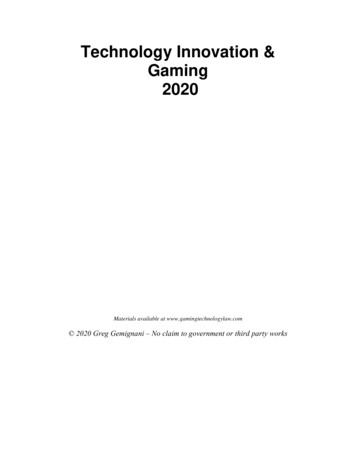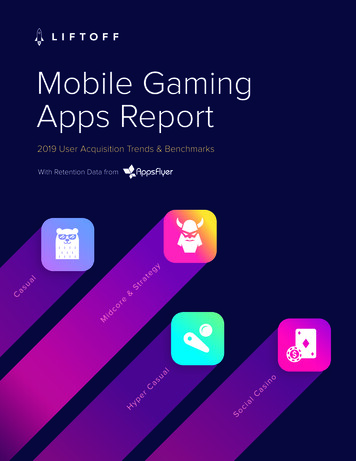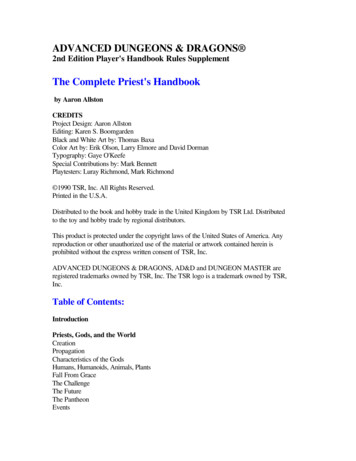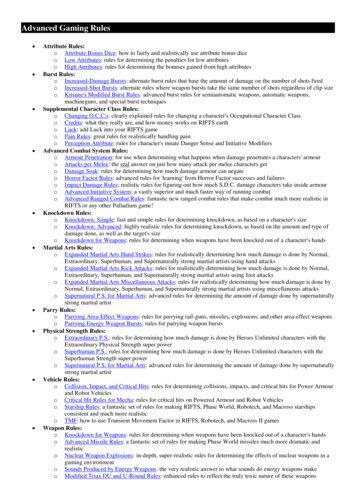
Transcription
Advanced Gaming Rules Attribute Rules:o Attribute Bonus Dice: how to fairly and realistically use attribute bonus diceo Low Attributes: rules for determining the penalties for low attributeso High Attributes: rules for determining the bonuses gained from high attributesBurst Rules:o Increased-Damage Bursts: alternate burst rules that base the amount of damage on the number of shots firedo Increased-Shot Bursts: alternate rules where weapon bursts take the same number of shots regardless of clip sizeo Kitsune's Modified Burst Rules: advanced burst rules for semiautomatic weapons, automatic weapons,machineguns, and special burst techniquesSupplemental Character Class Rules:o Changing O.C.C.s: clearly explained rules for changing a character's Occupational Character Classo Credits: what they really are, and how money works on RIFTS eartho Luck: add Luck into your RIFTS gameo Pain Rules: great rules for realistically handling paino Perception Attribute: rules for character's innate Danger Sense and Initiative ModifiersAdvanced Combat System Rules:o Armour Penetration: for use when determining what happens when damage penetrates a characters' armouro Attacks per Melee: the real answer on just how many attack per melee characters geto Damage Soak: rules for determining how much damage armour can negateo Horror Factor Rules: advanced rules for 'learning' from Horror Factor successes and failureso Impact Damage Rules: realistic rules for figuring out how much S.D.C. damage characters take inside armouro Advanced Initiative System: a vastly superior and much faster way of running combato Advanced Ranged Combat Rules: fantastic new ranged combat rules that make combat much more realistic inRIFTS or any other Palladium game!Knockdown Rules:o Knockdown: Simple: fast and simple rules for determining knockdown, as based on a character's sizeo Knockdown: Advanced: highly realistic rules for determining knockdown, as based on the amount and type ofdamage done, as well as the target's sizeo Knockdown for Weapons: rules for determining when weapons have been knocked out of a character's handsMartial Arts Rules:o Expanded Martial Arts Hand Strikes: rules for realistically determining how much damage is done by Normal,Extraordinary, Superhuman, and Supernaturally strong martial artists using hand attackso Expanded Martial Arts Kick Attacks: rules for realistically determining how much damage is done by Normal,Extraordinary, Superhuman, and Supernaturally strong martial artists using foot attackso Expanded Martial Arts Miscellaneous Attacks: rules for realistically determining how much damage is done byNormal, Extraordinary, Superhuman, and Supernaturally strong martial artists using miscellaneous attackso Supernatural P.S. for Martial Arts: advanced rules for determining the amount of damage done by supernaturallystrong martial artistParry Rules:o Parrying Area-Effect Weapons: rules for parrying rail-guns, missiles, explosions, and other area-effect weaponso Parrying Energy Weapon Bursts: rules for parrying weapon burstsPhysical Strength Rules:o Extraordinary P.S.: rules for determining how much damage is done by Heroes Unlimited characters with theExtraordinary Physical Strength super powero Superhuman P.S.: rules for determining how much damage is done by Heroes Unlimited characters with theSuperhuman Strength super powero Supernatural P.S. for Martial Arts: advanced rules for determining the amount of damage done by supernaturallystrong martial artistVehicle Rules:o Collision, Impact, and Critical Hits: rules for determining collisions, impacts, and critical hits for Power Armourand Robot Vehicleso Critical Hit Rules for Mecha: rules for critical hits on Powered Armour and Robot Vehicleso Starship Rules: a fantastic set of rules for making RIFTS, Phase World, Robotech, and Macross starshipsconsistent and much more realistico TMF: how to use Transient Movement Factor in RIFTS, Robotech, and Macross II gamesWeapon Rules:o Knockdown for Weapons: rules for determining when weapons have been knocked out of a character's handso Advanced Missile Rules: a fantastic set of rules for making Phase World missiles much more dramatic andrealistico Nuclear Weapon Explosions: in-depth, super-realistic rules for determining the effects of nuclear weapons in agaming environmento Sounds Produced by Energy Weapons: the very realistic answer to what sounds do energy weapons makeo Modified Triax DU and U-Round Rules: enhanced rules to reflect the truly toxic nature of these weapons
Expanded Rules for Attribute Bonus DiceWhile Palladium's rules for attribute bonus dice work fairly well for humans (who use 3D6 in eachattribute), they do not work very well for non-human races. These rules were written so that attribute bonusdice could be fairly applied to any R.C.C. or race, regardless of the number or type of attribute dice rolled.1. In order to qualify for a bonus die, the attribute rolled must be higher than 84% of the maximum rollpossible.Example 1: on 3D6 the maximum possible roll is 18, with 84% of 18 being 15.12, so you would have to roll16 or higher to qualify for a bonus.Example 2: the maximum roll on 4D6 is 24, where 84% of 24 is 20.16, so you need to roll 21 or higher toqualify for a bonus.2. Once you qualify for a bonus die, the 'size' of your bonus depends on the number of dice rolled for theattribute. As such, characters getting a bonus on a 1D6 attribute (where 16.6% of all rolls are exceptionalattributes) are going to get a bonus that is proportional to their attribute, and folks receiving a bonus on a4D6 roll (which happens less than 1% of the time) will receive a proportionally larger bonus. The size of thisbonus is formulated by making a ratio between the attribute being rolled and the base (which is 3D6, assupplied in the books).Example 1: since it is easier to get an exceptional attribute on a 2D6 roll, the bonus received is 2/3 the sizeof the bonus for an exceptional attribute bonus on 3D6.Example 2: the exceptional bonus on 5D6 is 5/3 the size of the bonus on 3D6.3. Expanding upon the first Conversion Book's rule about additional attribute bonus dice being gained whena 6 is rolled on an exceptional attribute, the maximum number of bonus dice a character can get is equal tothe number of dice rolled for their attribute. (Note that additional bonus dice are only gained when a 6 isrolled on the prior exceptional attribute roll.)Example 1: a player has an attribute roll of 16 on 3D6 (thus qualifying for a bonus die). If the player rolls a 6on that bonus roll, they gain an additional bonus die. If a 6 is rolled on that die, they gain another attributebonus die. However, because the attribute in question is 3D6, the maximum number of attribute bonus dicethat can be had is three.Example 2: a player rolls a 7 for a 2D4 attribute (qualifying it for an attribute bonus die). If the player rolls a4 (the maximum number possible) on their bonus die, then they get another bonus die. As the attribute inquestion on has two dice, the maximum number of bonus dice possible is two.The end result the Expanded Bonus Dice Rules is that the harder it is to qualify for the exceptional roll, themore potential gain you have. (As the difficulty goes up, so do the rewards)! This means that if you managethat one-in-a-million exceptional roll on a 6D6 attribute, you are going to get more than a lousy 1 for yourbonus!
Calculation of Exceptional AttributesNumber of Dice Rolled Exceptional Range Exceptional Bonus Maximum Exceptional DiceD61D661D6*(1/3)12D611, 121D6*(2/3)23D616 - 181D6*(3/3)34D621 - 241D6*(4/3)45D626 - 301D6*(5/3)56D631 - 361D6*(6/3)61D441D4*(1/3)12D47, 81D4*(2/3)23D411, 121D4*(3/3)34D414 - 161D4*(4/3)41D87, 81D8*(1/3)12D814 - 161D8*(2/3)23D821 - 241D8*(3/3)34D827 - 321D8*(4/3)41D109, 101D10*(1/3)12D1017 - 201D10*(2/3)23D1026 - 301D10*(3/3)3D4D8D10Example 1:Shargi, the Dwarven Operator rolls 22 on 4D6 for his P.S. Since 22 is within the exceptional attribute rangefor 4D6, he receives an attribute bonus die. On this bonus he rolls a 5. Shargi's final P.S. is 29! [22 rolled (4 rolled on the bonus x 4/3 for the 4D6 ratio) 2 for the R.C.C. bonus.]
Example 2:Aarg, the Orc Headhunter, rolls 11 on 2D6 for his P.B. attribute. As his roll is more than 84% of themaximum on 2D6, he qualifies for a bonus die. For this attribute bonus die, he rolls a 6! Since that rollqualifies Aarg for another bonus, he rolls an additional 1D6, and gets a four this time. Aarg's final P.B.attribute is an incredible 17! [11 rolled for the attribute (6 rolled on the bonus die x 2/3 for the 2D6 ratio) (4 rolled on the second bonus die x 2/3 for the ratio).)Example 3:Plutar, the Gargoyle Lord, rolls 26 on 5D6 for her SPD attribute. On her bonus die, she rolls a 2. Her finalSPD attribute is now 29. [26 rolled for the attribute (2 rolled on the attribute bonus die x 5/3 for the 5D6ratio).]Example 4:Luckey, the Kittani Warrior, rolls 18 on 3D6 for his P.P. attribute. On his attribute bonus die, he rolls a 6!This qualifies him for an additional bonus die, where he rolls another 6! This gets him another attributebonus die, and he rolls another 6!! Since Luckey's P.P. attribute is based on 3D6, he is limited to a maximumof three bonus dice. His final P.P. attribute is 39!! [18 rolled (6 for the first bonus x 3/3 for the ratio) (6rolled on the second bonus die x 3/3 for the ratio on 3D6) (6 rolled on the third attribute bonus die x 3/3for the ratio) 3 for his R.C.C. bonus.] Note: the odds of rolling six 6's in a row are 1 in 46,656.Low Attribute PenaltiesThe following chart can be used to determine what penalties are incurred have low attributes.AttributeI.Q.M.E.M.A.1Attribute Number Rolled234567-90% -80% -70% -60% -50% -40% -30%-4-4-3-3-2-2-195% 90% 85% 70% 50% 25% 15%P.S.-8-7-6-5-4-3-2P.P.-4-4-3-3-2-2-1P.E.-16% -14% -12% -10% -8% -6% -4%-4P.B.-4-3-3-2-2-195% 90% 80% 60% 40% 20% 10%I.Q.: one time penalty added to all skillsM.E.: penalty to save vs. psychic attack/insanityM.A.: chance to invoke distrust or scorn in othersP.S.: penalty to Hand-to-Hand combat damageP.P.: penalty to strike, parry, and dodgeP.E.: First row: penalty to save vs. coma/death. Second row: penalty to save vs. poison/magicP.B.: chance to invoke disgust or loathing in others
High Attribute BonusesThe types of bonuses gained from high attributes are as follows:I.Q.: one time bonus added to all skillsM.E.: bonus to save vs. psychic attack and insanityM.A.: chance to invoke trust or intimidation in othersP.S.: damage bonus in Hand-to-Hand combatP.P.: bonus to strike, parry, and dodge (at higher levels, an initiative bonus is shown on the second row)P.E.: First row: bonus to save vs. coma/death. Second row: bonus to save vs. magic and poisonP.B.: chance to charm or impress othersThe following chart can be used to determine exactly which bonuses are gained from high attributes.Attribute ScoreIQME MA PSPPPEPB17 3% 1 45% 2 1 5%35% 118 4% 2 50% 3 2 6%40% 219 5% 2 55% 4 2 8%45% 220 6% 3 60% 5 3 10%50% 321 7% 3 65% 6 3 12%55% 322 8% 4 70% 7 4 14%60% 423 9% 4 75% 8 4 16%65% 424 10% 5 80% 9 5 18%70% 525 11% 5 84% 10 5 20%75% 526 12% 6 88% 11 6 22%80% 627 13% 6 92% 12 6 24%83% 628 14% 7 94% 13 7 26%86% 729 15% 7 96% 14 7 28%90% 730 16% 8 97% 15 8 30%92% 831 16% 8 97% 16 8 31%92% 832 16% 8 97% 17 8 32%92% 833 16% 8 97% 18 8 33%92% 1 to initiative 834 16% 8 97% 19 8 34%92% 1 to initiative 835 16% 8 97% 20 8 35%92% 1 to initiative 8
36 16% 8 97% 21 8 36%92% 2 to initiative 837 16% 8 97% 22 8 37%92% 2 to initiative 838 16% 8 97% 23 8 38%92% 2 to initiative 839 16% 8 97% 24 8 39%92% 3 to initiative 840 16% 8 97% 25 8 40%92% 3 to initiative 841 16% 8 97% 26 8 41%92% 3 to initiative 842 16% 8 97% 27 8 42%92% 4 to initiative 843 16% 8 97% 28 8 43%92% 4 to initiative 844 16% 8 97% 29 8 44%92% 4 to initiative 845 16% 8 97% 30 8 45%92% 5 to initiative 846 16% 8 97% 31 8 46%92% 5 to initiative 847 16% 8 97% 32 8 47%92% 5 to initiative 848 16% 8 97% 33 8 48%92% 6 to initiative 849 16% 8 97% 34 8 49%92% 6 to initiative 850 16% 8 97% 35 8 50%92% 6 to initiative 8Alternate Burst Rules: Increased-Damage MethodThe amount of damage done in a burst is dependent on the number of rounds fired.Single Shot: sameShort Burst: now fires 3 shots/blasts and does ([1 shot] x2) damage.Long Burst/Full Burst: damage for a Long Burst (using up to half the clip, and one attack) or Full Burst(using more than half the clip, and two attacks); in either case, the damage is ([1 bullet] x [# of bullets/3]).Variable Shot BurstsType of Blast Number of Actions Used Amount of Ammo UsedDamage DoneSingle Shot11 shotdamage x 1Short Burst13 shotsdamage x 2Long Burst1variesdamage x (# shots fired / 3)Full Burst2variesdamage x (# shots fired / 3)Example: the 7.62 Galil assault rifle in Heroes Unlimited has a 40 round clip. A single bullet does 4D6. A
short burst would now fire 3 bullets and do 4D6 x 2 damage. A long burst could be from 4 bullets (4D6 x 1damage) to 20 bullets (4D6 x 6 damage). A full burst goes from 21 bullets (4D6 x 7 damage) to 40 bullets(4D6 x 13 damage). As you can see, this makes guns a little deadlier, and it means the guy who fires themost bullets does the most damage. Before, a guy with a .44 magnum could empty his 7 round clip and dojust as much damage as the guy with the above mentioned Galil.Alternate Burst Rules: Increased-Shots MethodRegardless of the size of the clip used in a weapon, bursts from that weapon always use the samenumber of shots. Therefore, larger clips allow you to fire a larger numbers of bursts.Example 1: C-12 Heavy Assault Laser RifleDamageDoneSingle4D6 M.D.ShotShort 4D6 x 2M.D.BurstNumber ofBlasts UsedNumber PossibleNumber Possible in aNumber Possiblein a Standard ELong E-Clip plus Ein a Long E-ClipClipCanister1203060457 (plus 2 singles)15LongBurst4D6 x 3M.D.10236FullBurst4D6 x 7M.D.2011 (plus 1 long)3Example 2: N
RIFTS or any other Palladium game! Knockdown Rules: o Knockdown: Simple: fast and simple rules for determining knockdown, as based on a character's size o Knockdown: Advanced: highly realistic rules for determining knockdown, as based on the amount and type of damage done, as well as the target's size

